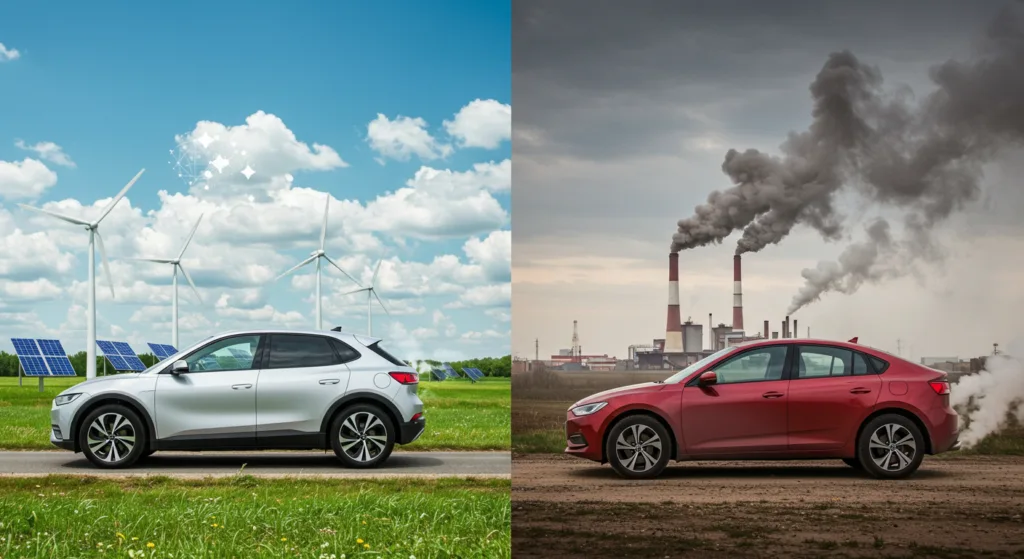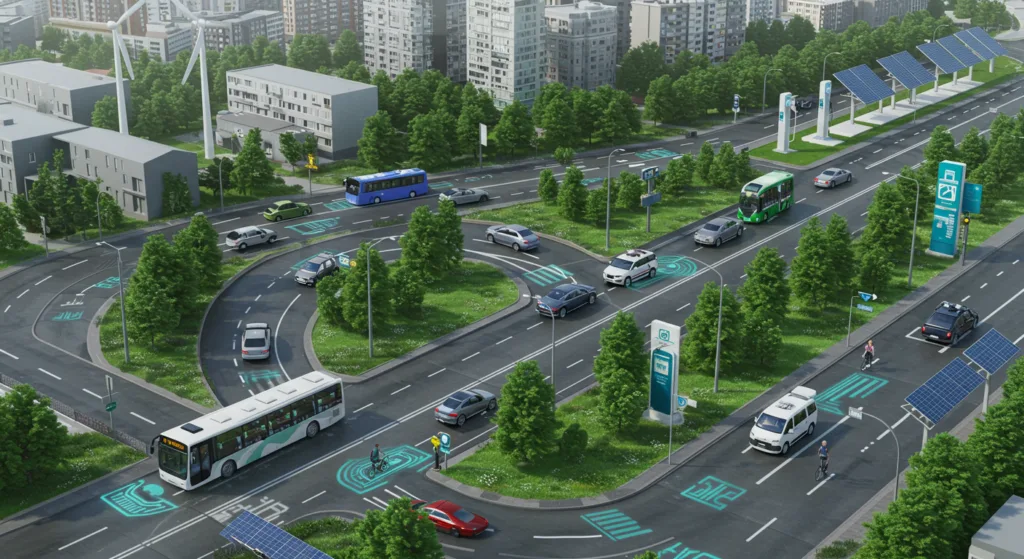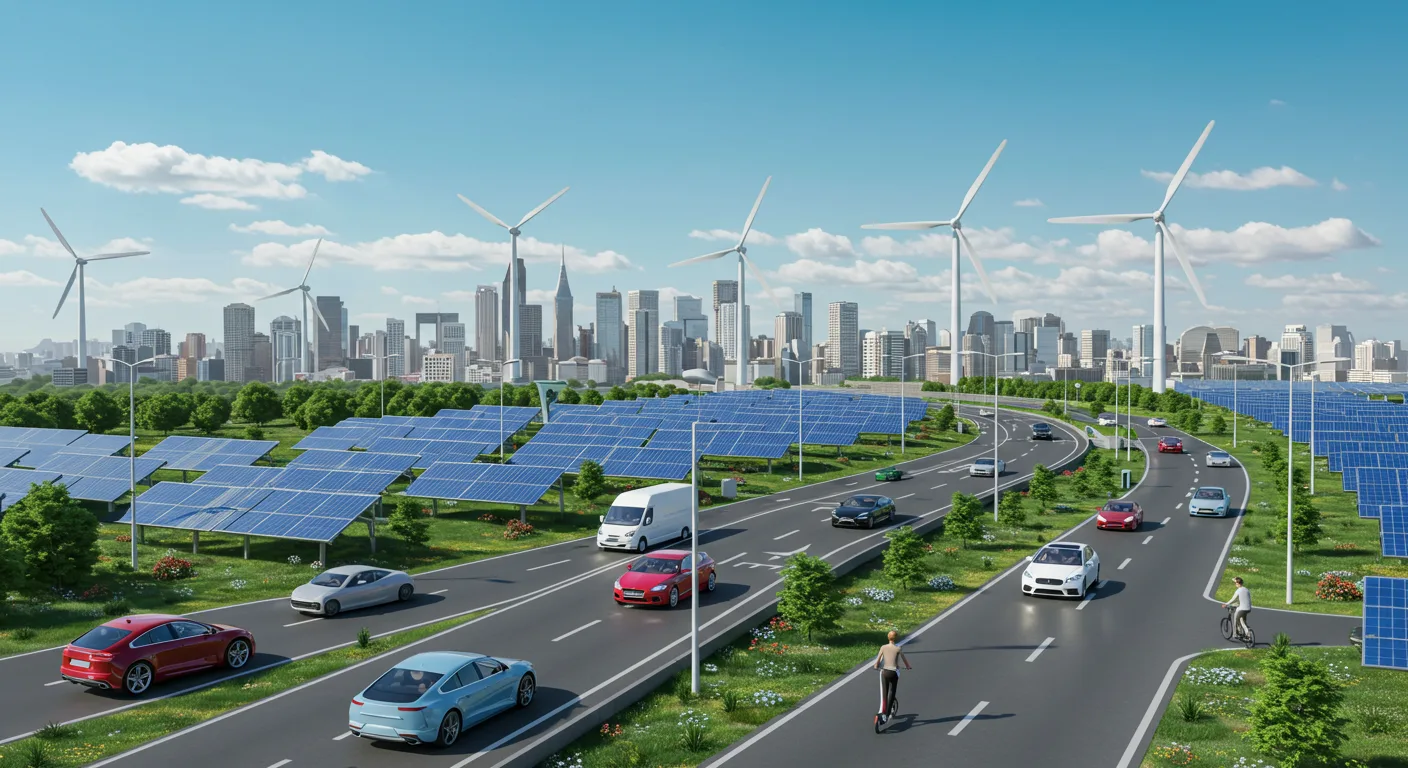Understanding the Environmental Impact of Electric Cars

Electric cars (EVs) have been widely promoted as a greener alternative to gasoline-powered vehicles, but are they truly better for the environment? While EVs offer lower emissions and greater energy efficiency, they also come with challenges related to manufacturing, battery production, and electricity sources. To understand their true environmental impact, we need to examine both the benefits and trade-offs of electric vehicle adoption.
How Do Electric Cars Reduce Carbon Emissions?
One of the biggest advantages of electric cars is their significantly lower carbon emissions compared to gasoline-powered vehicles. The transportation sector is responsible for a large percentage of global CO₂ emissions, and switching to EVs can help reduce the environmental footprint. Here’s how:
1. Zero Tailpipe Emissions
- Unlike gas-powered cars, EVs do not burn fossil fuels and produce zero tailpipe emissions.
- Traditional gasoline cars emit an average of 4.6 metric tons of CO₂ per year, depending on fuel efficiency and mileage.
- Over its lifetime, an EV emits 50-60% less CO₂ compared to a gas-powered vehicle.
2. Increased Energy Efficiency
- EVs convert more than 77% of electrical energy into vehicle movement, whereas internal combustion engines (ICEs) only convert 12-30% due to heat loss.
- This means less energy is wasted, making EVs much more efficient than traditional cars.
3. Lower Greenhouse Gas Emissions from Electricity Use
- While EVs require electricity for charging, their overall carbon footprint is still lower than gasoline vehicles, especially in regions that rely on renewable energy sources like wind, solar, or hydroelectric power.
- In places where coal is still the main electricity source, EVs may still indirectly contribute to emissions, but they still outperform gas-powered cars in total lifecycle emissions.
What Are the Environmental Costs of Manufacturing EVs?
While EVs help reduce emissions during their use, their manufacturing process—especially battery production—has a notable environmental impact. Producing an electric car can generate more emissions upfront than producing a gasoline-powered vehicle, but this is balanced out over the car’s lifetime.
1. Battery Production and Mining Impact
- EVs rely on lithium-ion batteries, which require raw materials like lithium, cobalt, and nickel.
- Mining for these materials leads to habitat destruction, water depletion, and high energy consumption.
- It’s estimated that EV battery production emits 60% more CO₂ than manufacturing a conventional car engine.
2. Factory Emissions During Vehicle Assembly
- Building an EV requires more energy than a gasoline vehicle due to the battery and advanced electrical systems.
- However, because EVs have fewer moving parts, they require less maintenance and fewer replacements over time, reducing their long-term environmental impact.
3. Carbon Payback Period
- Despite their higher initial production emissions, EVs offset their carbon footprint within 1.5 to 2 years of driving.
- After this period, their overall emissions become significantly lower than gasoline-powered cars.
Are Electric Car Batteries Sustainable?
One of the main environmental concerns with EVs is battery sustainability—from production to disposal. While batteries create some challenges, advancements in recycling and new technology are helping make them more eco-friendly.
1. Battery Longevity and Reusability
- Most EV batteries last between 8-15 years, depending on usage and climate conditions.
- Even after they are no longer efficient for vehicles, they can be repurposed for energy storage in homes and businesses.
2. Recycling and Second-Life Batteries
- Companies are developing closed-loop battery recycling processes to recover valuable materials like lithium, cobalt, and nickel.
- Up to 95% of a lithium-ion battery’s materials can be recovered and reused.
- Recycling reduces the need for new mining, lowering the overall environmental impact of EV production.
3. The Future of Sustainable EV Batteries
- Researchers are working on solid-state batteries, which are expected to be more energy-efficient, have a longer lifespan, and require fewer rare materials.
- The push for sodium-ion batteries, which eliminate the need for lithium and cobalt, could revolutionize EV sustainability in the near future.
While electric cars are not completely free from environmental concerns, their long-term benefits far outweigh their initial drawbacks. With continued advancements in battery technology, recycling efforts, and clean energy production, EVs will play a crucial role in reducing global carbon emissions and making transportation more sustainable. 🚗⚡🌍
🚗 Pro Tip: If you’re considering an Electric Car, check your local electricity grid’s energy mix. Charging with renewable energy sources like solar or wind makes your EV even more eco-friendly. Installing home solar panels can help you drive on 100% clean energy.
Comparing Electric Cars vs. Gasoline Cars: Which is Greener?

Electric vehicles (EVs) have been widely promoted as an eco-friendly alternative to gasoline-powered cars. However, the real question is: Are they truly greener throughout their entire lifecycle? While EVs produce no tailpipe emissions, their overall sustainability depends on factors such as manufacturing emissions, energy sources for charging, and battery disposal. Let’s break down how EVs compare to gasoline cars in terms of environmental impact.
Do Electric Cars Have a Lower Carbon Footprint Over Time?
A vehicle’s carbon footprint includes emissions from manufacturing, operation, and disposal. While EVs have higher production emissions due to battery manufacturing, they quickly offset these emissions through clean energy use.
1. Emissions from Manufacturing vs. Lifetime Use
- EV production—especially battery manufacturing—generates 40-60% more CO₂ than gasoline cars.
- However, once on the road, an EV produces zero tailpipe emissions, whereas gas cars release 4.6 metric tons of CO₂ per year on average.
- A 2022 study by the International Council on Clean Transportation (ICCT) found that over a typical vehicle’s lifespan, EVs emit 60-70% less carbon than gasoline cars, even in regions with fossil-fuel-based electricity.
2. Carbon Payback Period
- The “carbon payback period” is how long an EV needs to be driven to offset its higher manufacturing emissions.
- Studies suggest that within 1.5 to 2 years, an EV neutralizes its manufacturing footprint and becomes significantly greener than a gas-powered vehicle.
3. Long-Term Benefits of EV Adoption
- If the electricity grid shifts further toward renewable energy, EVs could achieve near-zero lifecycle emissions in the future.
- In contrast, gasoline cars will continue to burn fossil fuels throughout their lifespan, making them unsustainable long-term.
How Does Electricity Production Affect EV Sustainability?
The environmental benefits of electric vehicles depend on how the electricity used for charging is generated. If an EV is charged using coal-generated electricity, its sustainability advantage is reduced, but it still outperforms gasoline vehicles.
1. Regional Differences in Electricity Sources
- In countries like Norway, where 98% of electricity comes from renewable sources, EVs are nearly emission-free.
- In contrast, an EV in a coal-dependent country still emits less CO₂ than gasoline cars, but the difference is smaller.
- According to the U.S. Department of Energy, even in regions where 50% of electricity comes from coal, EVs still emit 30-50% less CO₂ over their lifetime than gas cars.
2. The Rise of Renewable Energy for EV Charging
- The shift towards solar, wind, and hydroelectric power means that EVs are getting cleaner every year.
- Home solar panel systems can allow EV owners to charge their vehicles with 100% renewable energy, making them completely carbon-neutral.
3. The Efficiency Factor: EVs Still Win
- Internal combustion engines (ICEs) waste 60-70% of their fuel energy as heat, whereas EVs convert over 75% of electricity directly into motion.
- Even when charged using fossil fuels, EVs are more energy-efficient than gasoline vehicles.
What Happens to Old EV Batteries? Recycling and Disposal
One of the biggest environmental concerns with EVs is battery disposal. Unlike traditional gasoline engines, EVs rely on lithium-ion batteries, which contain valuable but resource-intensive materials like lithium, cobalt, and nickel.
1. Do EV Batteries Create a Waste Problem?
- EV batteries do not go straight to landfills after their automotive life. Many are repurposed for energy storage or recycled to recover valuable materials.
- Currently, less than 5% of lithium-ion batteries are thrown away; the rest are either reused or processed for material recovery.
2. The Growing Battery Recycling Industry
- Companies like Redwood Materials, Tesla, and Umicore are developing closed-loop recycling systems to extract and reuse lithium, cobalt, and nickel from old batteries.
- Recycling can recover up to 95% of a battery’s materials, significantly reducing the need for new mining.
3. Second-Life Use for EV Batteries
- Many retired EV batteries are still usable for stationary energy storage, powering homes, businesses, or renewable energy grids.
- Nissan and BMW have launched battery repurposing projects, using old EV batteries to store solar and wind energy.
With continued advancements in battery technology, recycling systems, and renewable energy, EVs are set to become even more sustainable in the future. The key to making EVs fully eco-friendly lies in better recycling solutions and cleaner electricity grids—both of which are rapidly improving. 🚗⚡🌿
💡 Inspiring Quote:
“The future belongs to those who prepare for it today.” – Malcolm X
Transitioning to electric vehicles is not just about technology—it’s about shaping a cleaner, greener world for future generations.
The Future of Eco-Friendly Transportation and Electric Cars

The transition to electric vehicles (EVs) is just one step toward sustainable transportation, but true eco-friendliness depends on how these vehicles are powered and manufactured. As governments push for clean energy policies and technology advances, the future of EVs looks increasingly green. But can we truly make electric cars 100% sustainable? Let’s explore the role of renewable energy, government initiatives, and future innovations in shaping eco-friendly transportation.
Can Renewable Energy Make EVs 100% Green?
While electric cars produce zero tailpipe emissions, their overall sustainability depends on how the electricity they use is generated. If charged using coal-powered electricity, their carbon footprint is higher. However, as the world moves toward renewable energy, EVs are becoming greener than ever.
1. The Role of Solar, Wind, and Hydropower
- Countries like Norway, Iceland, and Costa Rica already generate over 95% of their electricity from renewables, making EVs in these regions nearly carbon-neutral.
- In the U.S., solar and wind energy are growing rapidly, with renewable sources accounting for 22% of electricity generation in 2022, up from 10% in 2010.
- Homeowners with solar panels can charge their EVs entirely with self-generated clean energy, making them 100% green.
2. The Shift Toward Greener Charging Infrastructure
- Charging stations powered by solar energy are increasing, with companies like Tesla and Electrify America building solar-powered superchargers.
- In Germany and California, regulations require new EV chargers to be powered by renewable sources, ensuring a cleaner charging network.
3. Smart Grids and Energy Storage
- Future smart grids will allow EVs to store excess renewable energy and feed it back into the grid, reducing waste and stabilizing electricity supply.
- Bidirectional charging will turn EVs into mobile energy storage units, helping power homes and businesses during peak demand.
The more we decarbonize electricity production, the greener EVs become. A fully renewable-powered EV future is within reach, but it depends on government policies, investment in clean energy, and widespread infrastructure improvements.
What Are Governments Doing to Promote Sustainable EVs?
Governments worldwide are implementing policies, incentives, and regulations to make EV adoption smoother, more affordable, and more sustainable. From financial incentives to infrastructure development, these actions are shaping a greener future for transportation.
1. Financial Incentives and Subsidies
- Many countries offer EV tax credits and rebates to encourage adoption.
- U.S.: Federal tax credits of up to $7,500 for new EV buyers.
- EU: Countries like France and Germany offer subsidies up to €6,000 for EV purchases.
- China: Major EV subsidies, including reduced registration fees and tax exemptions.
- Many governments are phasing out incentives for gas-powered cars, making EVs financially more attractive.
2. Investment in Charging Infrastructure
- The EU plans to install 1 million EV charging stations by 2025.
- The U.S. is investing $7.5 billion in nationwide fast-charging networks, ensuring chargers are available every 50 miles on highways.
- Many countries now require apartment buildings and offices to include EV chargers in new developments.
3. Stricter Emission Regulations and Gas Car Bans
- Norway will ban new gas car sales by 2025, leading the world in EV adoption.
- California and the EU will phase out new gasoline vehicle sales by 2035, making EVs the default choice.
- Governments are increasing emission penalties on automakers producing gas-powered cars, pushing companies to focus on EV production.
By combining financial incentives, infrastructure expansion, and strict regulations, governments are ensuring a smoother transition to sustainable EV adoption.
Will EV Technology Continue to Reduce Environmental Impact?
While EVs are already greener than gasoline cars, the future promises even more sustainable innovations. Researchers and automakers are working on next-generation technology to further reduce environmental impact from manufacturing to battery disposal.
1. Solid-State Batteries: The Game Changer
- Unlike lithium-ion batteries, solid-state batteries are lighter, charge faster, and last longer.
- These batteries reduce reliance on rare minerals like cobalt, making production less environmentally damaging.
- Toyota, Volkswagen, and BMW are investing heavily in this next-gen battery tech, with mass production expected by 2027-2030.
2. EV Recycling and Circular Economy
- Current EV batteries retain up to 80% of their capacity even after they are no longer suitable for vehicles.
- Companies like Redwood Materials and Umicore are refining battery recycling methods, recovering up to 95% of battery materials for reuse.
- Governments are introducing battery recycling laws, ensuring responsible disposal and reducing reliance on new mining operations.
3. Greener EV Manufacturing
- Automakers are transitioning to zero-emission factories, using renewable energy for vehicle production.
- Tesla’s Gigafactories run on solar energy, while Volvo and BMW are working toward 100% carbon-neutral car manufacturing.
- Some EV manufacturers are exploring plant-based or recycled materials for car interiors to further reduce environmental impact.
With continuous advancements in battery technology, recycling, and eco-friendly manufacturing, EVs are set to become even more sustainable. While they are not perfectly green yet, they are undoubtedly the future of eco-friendly transportation. 🚗⚡🌍
The Electric Car is shaping the future of eco-friendly transportation, offering lower emissions, energy efficiency, and innovative technology. As renewable energy and battery recycling improve, EVs will become even more sustainable. 🚗⚡
⏳ Reminder:
Before buying an electric car, research battery lifespan, charging options, and government incentives in your area. The right EV choice depends on your driving habits, charging accessibility, and sustainability goals. 🚗⚡🌱
Do you think electric cars are the future? Join the conversation and share this article on social media to spread awareness about green mobility! 🌍♻️



